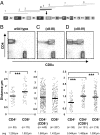Replication allows inactivation of a knocked-in locus control region in inappropriate cell lineages
- PMID: 20837519
- PMCID: PMC2947902
- DOI: 10.1073/pnas.1010317107
Replication allows inactivation of a knocked-in locus control region in inappropriate cell lineages
Abstract
To study the influence of a locus control region (LCR) on the expression of a highly characterized, developmentally regulated locus, we have targeted the hCD2-LCR as a single copy into the endogenous mouse CD8 gene complex. Two knock-in mouse lines that differ in the integration site of the hCD2-LCR within the mCD8 gene complex were generated, and the influence on expression of the CD8 coreceptor was assessed. In these mice the normal developmental silencing of the CD8 genes in the CD4 lineage is deregulated, and the mice develop CD4(+) cells that also express the CD8 genes. This is accompanied by the physical maintenance of the CD8 genes within an extended loop away from their subchromosomal territory. Further analysis of these mice revealed unexpected fluid chromatin dynamics, whereby the LCR can be initially dominant over the endogenous CD8 gene-repressive regulatory processes present in CD4(+) cells but is continuously contested by them, resulting in the eventual inactivation of the inserted LCR, probably as a result of multiple rounds of replication.
Conflict of interest statement
The authors declare no conflict of interest.
Figures






References
-
- Kioussis D, Ellmeier W. Chromatin and CD4, CD8A and CD8B gene expression during thymic differentiation. Nat Rev Immunol. 2002;2:909–919. - PubMed
-
- Rocha B. The extrathymic T-cell differentiation in the murine gut. Immunol Rev. 2007;215:166–177. - PubMed
-
- Vremec D, Pooley J, Hochrein H, Wu L, Shortman K. CD4 and CD8 expression by dendritic cell subtypes in mouse thymus and spleen. J Immunol. 2000;164:2978–2986. - PubMed
-
- Hostert A, et al. A CD8 genomic fragment that directs subset-specific expression of CD8 in transgenic mice. J Immunol. 1997;158:4270–4281. - PubMed
-
- Hostert A, et al. A region in the CD8 gene locus that directs expression to the mature CD8 T cell subset in transgenic mice. Immunity. 1997;7:525–536. - PubMed
Publication types
MeSH terms
Substances
Grants and funding
LinkOut - more resources
Full Text Sources
Molecular Biology Databases
Research Materials

